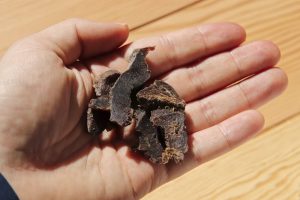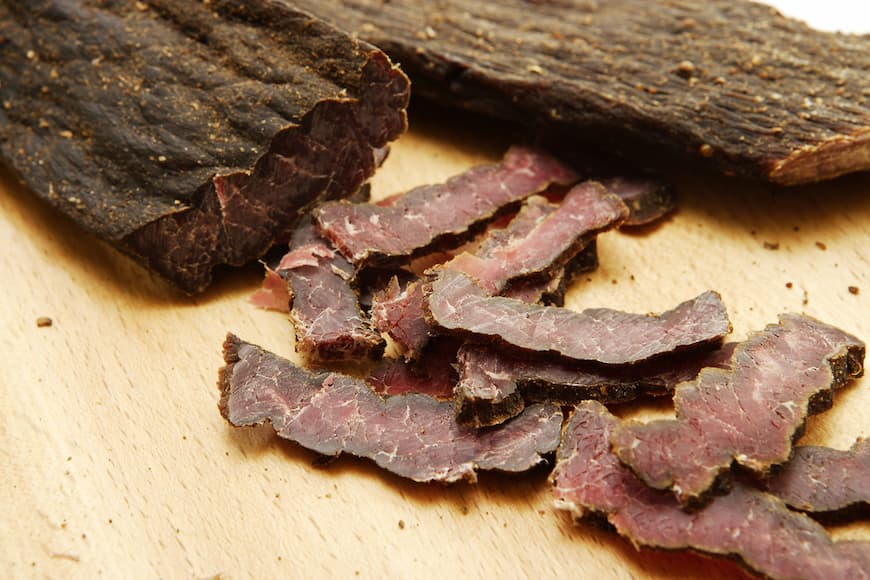What is biltong
Biltong is a form of cured, dried meat that originated in Southern Africa. I call it the prosciutto of Africa. Many types of meat are used to produce it. These range from beef to game meats. Biltong was created out of necessity to preserve meat and has now become a trendy, high-protein snack. Is biltong like beef jerky? It is related to beef jerky in that they are both spiced, dried meats. The main difference is, however, the ingredients, taste, and processes used to produce the final product.

History of biltong
Biltong has actually been around for centuries and can be traced back to South Africa. Before refrigeration, people needed a way to preserve excess meat after slaughter. Used basic resources like salt, the meat was cured and hung to dry, preventing the meat from spoiling.
Let’s make some biltong
Making biltong the traditional South African way is an easy and immensely satisfying process. Not only will you impress your friends, but you will also save money as biltong can be very expensive. The result will be a delicious high-protein snack that your guests will adore.
Meat selection
There is a variety of meats that can be transformed successfully into biltong. Everything from beef, fish to turkey. Traditionally beef is used and is a great starting point. Venison and game meat is a popular choice due to its leaner quality but does have a specific taste. The standard factors of cut, aging and fat content apply and will impact your biltong in the same way they do when you cook with these meats.
Choose protein according to your preference and what’s available to you. An important factor to bear in mind is fatty meats are more likely to spoil during the drying process. While you can use prime cuts, you get better value from these if you cook them. We suggest finding a balance between quality and cost.
The meat will lose moisture during the drying process, so you’ll most likely be buying in larger quantities. In this example, we’re using four and half pounds of sirloin or porterhouse steaks bought from a local supermarket.
Preparation
Begin by removing excess fat. This will assist with the drying process, and ensure a long-lasting final product. We recommend leaving some fat for extra flavor or remove completely if you not a fan.
Roughly cut the meat 8 inches in length, and ½ inch in thickness is ideal. Don’t cut the slices too thick or they will take too long to dry. Remove any gristle/sinew – these bits become extremely tough to chew when dried. Longer strips are more space-efficient for drying and reduce the number of drying hooks you’ll need to use.
Basting and seasoning recipe | for approximately 4 pounds of meat
- 1 cup vinegar (for basting)
- 1/2 cup ground coriander seed
- 2 Tbs ground black pepper
- 2 Tbs sea salt
- 2 tsp paprika
The best way to prepare meat for drying is to baste and season simultaneously. Start by adding a layer of your basting mix (vinegar) and seasoning spices to the bottom of a wide, flat dish or tray.
Lay your steaks flat in the dish, then add another equal layer of basting and seasoning on top. Additional spices like paprika and chili flakes can be added according to your preference for spicy flavorings. Let the steaks marinate overnight or for two to four hours in the fridge before proceeding to the drying phase.
Drying
You can dry biltong in an isolated, dry space like a boiler room or a specially constructed chamber like a biltong maker. Biltong makers allow you to control the heat and protect the meat from flies and insects. Humidity is not your friend and is the primary cause of spoilt biltong. So creating the correct environment for drying is an essential part of the process, especially in colder or more humid climates.
Depending on the amount of meat and method of drying you use, it can take anything from 24 hours to 10 days to complete the process. Personal taste also comes into play, as some like their biltong moist while others prefer the rock hard variety.
Experimentation
Once you’ve mastered the basics, you can start experimenting. Try different meats, seasoning, basting, and drying techniques for your very own signature biltong. Go on, be adventurous.
Last updated: September 24, 2023


